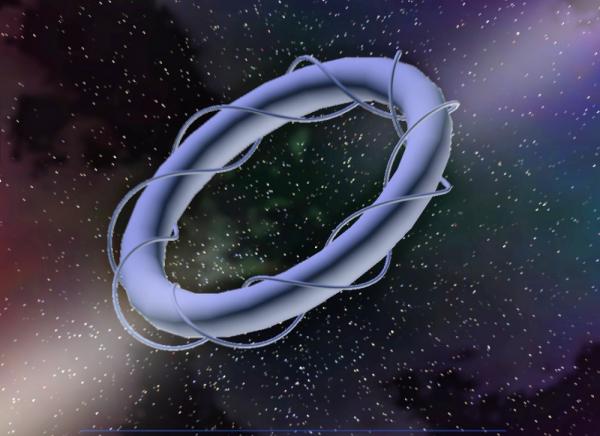BY LETTER
Galbydeia Torus
Galactography > Regions of Space > Middle Regions/Hinter-regions
Galactography > Sephirotic Empires > Mutual Progress Association
Galactography > Systems and Worlds > Systems & Worlds G - H
Galactography > Sephirotic Empires > Mutual Progress Association
Galactography > Systems and Worlds > Systems & Worlds G - H
 Image from Steve Bowers |
One of the most infamous Mutual Progress Association megaengineering projects ever, the Galbydeia Torus remains a point of controversy among the member systems.
It was originally suggested by the Archons of Galbydeia in 7830 to explore the possibilities of large scale spacetime engineering - instead of just opening microscopic wormholes it would rip macroscopic wormholes straight into existence, possibly revolutionizing the wormhole manufacturing business. In addition it could potentially provide invaluable information about subfemtolevel physics. They convinced a number of AIs, megaengineering consortia and autoreplication facilities to join the project, arousing enthusiasm in many physicists and space-time engineers.
Over the next millennium they laboured with gathering, converting and arranging mass into the Torus. To construct it they used a large mobile wormhole to bring matter from several star systems to Galbydeia, compressing it into nuclear matter or metallic hydrogen. The total mass was roughly a fifth solar mass.
The Torus is ten kilometers in diameter, composed of a magmatter pipe containing superfluid maghelium. The pipe is twisted into a torus knot winding around the Torus. To hold the pipe in place 535 small black holes are orbiting inside the core of the knot and around it, in turn kept aligned using electromagnetic fields and also used as Hawking matter-energy converters. The whole project was a tour de force of MPA megatechnological and transapientech know-how with an astronomical price tag.
When the maghelium was accelerated towards lightspeed, an intense gravitomagnetic field developed inside the knot, which in turn induced a gravitational field in the torus hole. As the field developed, various field inductors on the torus rim attempted to use it to coax a quantum wormhole to spontaneously inflate to fit the torus (not unlike the failed NoCoZo Ynity Gate experiments many millennia before).
In 8944 success was reported - a wormhole had emerged, linking the Torus to another place. After the initial enthusiastic press releases the project became much more cautious. Their wormhole did not lead to another location. Rather, it was a branching structure of uncertain geometry, not quite untraversable but not clearly leading anywhere. Several expensive attempts during the next century led to the same conclusion: the Torus could not produce any traversable wormhole to any place in the universe. It could, however - at a tremendous cost of energy - create bizarre baby-universe-like structures branching forever into quantum labyrinths, streams of minor black holes or devastating gravitational waves. Interest waned and the supporting consortia began to withdraw.
The Archons of Galbydeia continued to tend their sacred Torus. Over the years they had come to identify with their grand Project, seeing it more and more as the greatest goal of all. They believed it was they key to understanding the universe, the portal to the hereafter or Omegapoint. Many expeditions were sent into the wormhole labyrinths, seeking the path to the micromega or "Planck portal". They attracted other technomegist groups, and Galbydeia became a center for experiments in sacred megatechnology.
Today Galbydeia is inhabited by a large number of space-time engineers, megatechnology admirers, omegist sects, some Keterist offshoots, a number of cults worshipping the Torus (the most well-known, Servants of the Gateway, await the day when it will finally open the link directly to God and the Divine will flash through it to re-absorb the universe into perfection) and even a small secretive colony from the Daharran Unity.
The torus orbits Galbydeia Due, a dim M star surrounded by a vast disc of metatechnological debris from the construction project and later eras (including the largest collection of artificial black holes in any system; this collection is currently used by the Tarynt-Ometa Clade in an experiment with gravity transmission).
Most inhabitants live in habitats around Galbydeia Ono at a safe distance. Still, there have been occasional panics when the Torus had threatened to break up. The most serious incident occurred in 9733 when a complex gravity mode during another opening experiment induced spins on the stabilising black holes. The maintenance AI managed to stabilise the Torus by sacrificing 32 black holes and partially wrecking the supporting structure, but the Torus remained stable. Had it broken up the detonation would have wiped out all life within the system. Since then the Torus has been repaired, but it is clear that Galbydeia is not a safe system. There has been several incidents of terrorism against the Torus, but all have been repelled by the Archon Guards so far.
Related Articles
Appears in Topics
Development Notes
Text by Anders Sandberg
Initially published on 12 November 2000.
Initially published on 12 November 2000.






